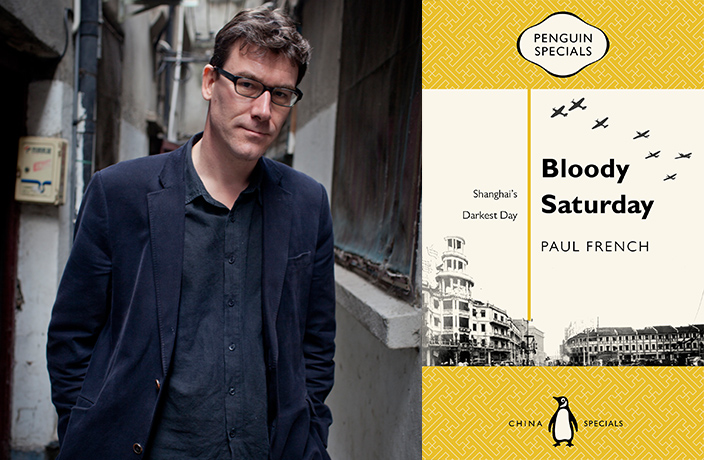Saturday, August 14, 1937 – Shanghai was expecting to be hit by a typhoon of ‘violent intensity.’ The typhoon passed, but what did strike Shanghai was a man-made typhoon of bombs and shrapnel that brought aerial death and destruction such as no city had ever seen before.
The clock outside the Cathay Hotel stopped at 4.27pm precisely as the first bombs landed on the junction of Nanking Road and the Bund; the second wave of explosions struck the dense crowds outside the Great World amusement centre in the French Concession.
In Bloody Saturday: Shanghai's Darkest Day, New York Times bestselling author Paul French (Midnight in Peking, City of Devils) reconstructs the events of that dreadful day from eyewitness accounts. We caught up with him back in 2018 for a few questions...
There are some real characters among the eyewitnesses. Do you have a favorite?
The Old Shanghai journalists always amaze me – Vanya Oakes was an American 'lady reporter' who 'sampan hopped' across Suzhou Creek (i.e. the Creek was so full of sampans - flat bottomed Chinese wooden boat - she could jump from one to another to cross the river) to get back to her room at the Astor House Hotel (Pujiang).
As she made her mad dash bombs were falling, sampans were being ripped apart by shrapnel and crowds were stampeding across the Garden Bridge (Waibaidu) just above her head. She did all this with her best high heels in her hands to keep them dry, and then eventually sat down to lamb chops in the Grill Room of the Astor.
John Morris, another foreign journalist, found himself behind Japanese lines up on Range Road (Wujin Lu), up near the old North Railway Station (now the Shanghai Railway Museum on Tianmu Dong Lu). He needed to phone in the story of the Japanese advance and the fighting in northern Hongkew (Hongkou), so dived into a Japanese temple and commandeered their telephone to file his copy.
George Battey was an American journalist on several Chinese newspapers. A bit of an oddball by all accounts, he wrote one of the first biographies of Wallis Simpson (Duchess of Windsor) who he'd known when she cavorted round town for a couple of weeks in the 1920s.
He lived up in Kiangwan (Jiangwan) where few foreigners lived at the time. As the Japanese attacked he stuck a Stars and Stripes on the roof of his house hoping the soldiers would pass him by. Despite being six feet two inches tall, Battey clambered into his five-foot iron bathtub with a loaf of bread and a tin of salmon when the shooting started.
When the firing quietened in the evening, he pumped up the tires on his bicycle, strapped his typewriter, shaving kit and some personal belongings to the back, and stuck Old Glory on a pole attached to the back wheel. He then rode four miles through the skirmishing soldiers in northern Shanghai to the American Consulate, cutting a rather bizarre figure clad only in a bathing costume and khaki shorts.
Which was the most striking description of the day you came across in compiling the book?
There are several moment when witnesses recall looking up to the sky at approximately 4.27pm and seeing the bombs leave the planes and start heading towards them on the Bund. The first two hit the Palace Hotel (now the Swatch Art Peace Hotel) and the Cathay opposite (now the Peace Hotel). Then there was, after the expected almighty explosion, a strange minute of quiet and calm, until alarms sounded, masonry collapsed, and the dying starting screaming for help. That is rather unsettling.
I also like anecdotes that reflect the mood of Shanghailanders. After clearing up the street somewhat and helping the dead and dying into the ambulances outside the Cathay Hotel, several men went downstairs to the Horse and Hounds Bar (still there). One found a severed thumb on the floor – a truly macabre moment. "Anyone lost this?" he asked – that kind of dark humor is very telling of the times and Shanghai at that period I think.
You say this was the second devastating aerial bombardment of a city after Guernica – did it have the same effect on the collective consciousness of the world?
At the time Bloody Saturday was an immense event in the world's media – it was a front page story for days. On August 28th 'Newsreel Wong's' famous picture appeared of the poor Chinese baby in the rubble of Shanghai's South station appeared.
That picture was seen by an estimated 136 million people worldwide in their morning newspaper. It was incredibly influential in swaying the world to China's cause against Japan in World War Two.
Of course later we rather lost touch with Shanghai, and our collective memories rather forgot Bloody Saturday. Guernica has stayed in people's minds of course not least because of the famous Picasso mural.
But at the time Shanghai was on everybody's lips and a symbol of the cruelty and devastation that aerial bombardment – the sort cities like London, Manchester, Liverpool, Belfast and the German cities were to see several years later – could bring.
How did the Chinese pilots come to bomb their own city?
It was an awful mistake. The Japanese battle cruiser Idzumo was moored up on the Huangpu right opposite the Japanese Consulate (next to where the Russian Consulate is today) and firing hundreds of shells into the Chinese districts of Shanghai – Paoshan (Baoshan) and Chapei (Zhabei).
They devastated those areas – a devastation we can still see clearly today in the lack of old buildings in those areas. They started awful fires that swept up whole streets and forced hundreds of thousands of Chinese families to flee the city - into the countryside, but also into the International Settlement and the French Concession.
The odds were against the pilots. August is typhoon season - there was low cloud, rain. It's a tight target to hit a ship on the Huangpu so close to Hongkou, the Bund and Pudong. It was a dreadful miscalculation.
Bloody Saturday is a Penguin China Special – what appeals to you about the format?
I love writing Penguin China Specials – I've done three now (The Badlands about the old lowlife foreigners of Peking in the 1930s; Betrayal in Paris about the Chinese delegation at the Treaty of Versailles in 1919 at the end of WW1; and now Bloody Saturday). They allow you to tell more stories and to recognize anniversaries.
Bloody Saturday is a major plot turning point in my new book City of Devils, out in November from Penguin, which is the stories of the foreign gangsters of 1930s and 1940s Shanghai. But I realized that we were fast approaching the 80th anniversary of Bloody Saturday and that it should be commemorated somehow. The Specials format of about 20,000 words forces you to be concise and informative, but hopefully gives the reader a quick and captivating history lesson.
Tell us more about City of Devils...
City of Devils moves on from my last book Midnight in Peking and comes to Shanghai to talk about the laowai criminals, casino managers, gangsters, drug dealers, pimps and general nightlife ne'erdowells of the late 1930s and 1940s.
After Bloody Saturday the foreign concessions of Shanghai were surrounded by the Japanese Army – the so-called Solitary Island (Gudao) period. this is when Shanghai really let rip because tomorrow looked so uncertain. In western Shanghai – along Yanan Lu, around Huashan Lu, Jiangsu Lu, Yuyuan Lu and what is now Fahuazhen Lu was the 'Badands' – mostly foreign run casinos and nightclubs
City of Devils is, like Midnight in Peking, a true story – that of two men whose lives intertwined in Shanghai in crime and twisted friendship. The self-proclaimed Jack Riley who had acid-burnt fingertips and made a fortune as the city's slot machine King, and Joe Farren, a man whose name was printed in neon across the Badland’s and who ran the best nightclubs and biggest casinos in Asia.
‘Lucky Jack’ and 'Dapper Joe' collided, crashed and came together again despite all odds. Between gambling, drugs and corruption, the book is really about a side of Shanghai that has since been long forgotten, but was truly wild and ended with Pearl Harbor. I really hope people like it – the publishers are all very excited and the TV rights got snapped up after a "think Boardwalk Empire in Old Shanghai" pitch, so I'm delighted really!
Bloody Saturday: Shanghai's Darkest Day is available on Amazon.
For more on Paul French, click here. For more This Day in History stories, click here.
This interview was first published in 2018.
[Cover image by Nicky Almasy]
























0 User Comments